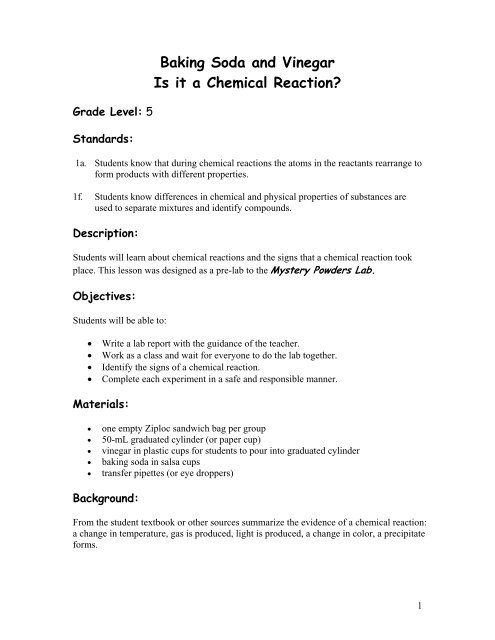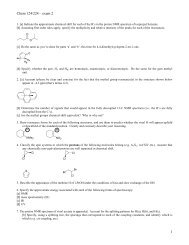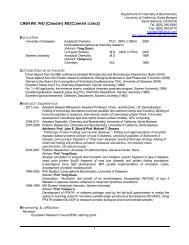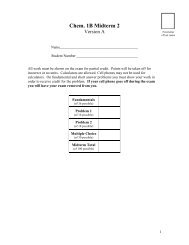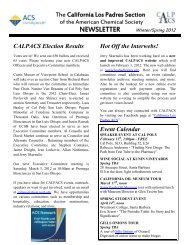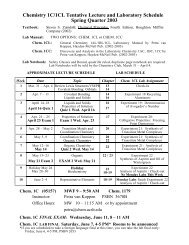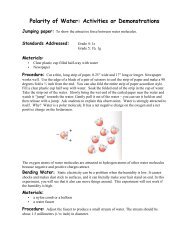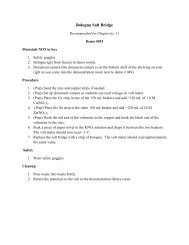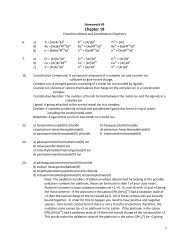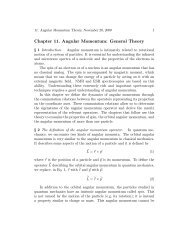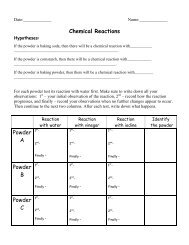Baking Soda and Vinegar Is it a Chemical Reaction?
Baking Soda and Vinegar Is it a Chemical Reaction?
Baking Soda and Vinegar Is it a Chemical Reaction?
Create successful ePaper yourself
Turn your PDF publications into a flip-book with our unique Google optimized e-Paper software.
Grade Level: 5<br />
St<strong>and</strong>ards:<br />
<strong>Baking</strong> <strong>Soda</strong> <strong>and</strong> <strong>Vinegar</strong><br />
<strong>Is</strong> <strong>it</strong> a <strong>Chemical</strong> <strong>Reaction</strong><br />
1a. Students know that during chemical reactions the atoms in the reactants rearrange to<br />
form products w<strong>it</strong>h different properties.<br />
1f. Students know differences in chemical <strong>and</strong> physical properties of substances are<br />
used to separate mixtures <strong>and</strong> identify compounds.<br />
Description:<br />
Students will learn about chemical reactions <strong>and</strong> the signs that a chemical reaction took<br />
place. This lesson was designed as a pre-lab to the Mystery Powders Lab.<br />
Objectives:<br />
Students will be able to:<br />
• Wr<strong>it</strong>e a lab report w<strong>it</strong>h the guidance of the teacher.<br />
• Work as a class <strong>and</strong> wa<strong>it</strong> for everyone to do the lab together.<br />
• Identify the signs of a chemical reaction.<br />
• Complete each experiment in a safe <strong>and</strong> responsible manner.<br />
Materials:<br />
• one empty Ziploc s<strong>and</strong>wich bag per group<br />
• 50-mL graduated cylinder (or paper cup)<br />
• vinegar in plastic cups for students to pour into graduated cylinder<br />
• baking soda in salsa cups<br />
• transfer pipettes (or eye droppers)<br />
Background:<br />
From the student textbook or other sources summarize the evidence of a chemical reaction:<br />
a change in temperature, gas is produced, light is produced, a change in color, a precip<strong>it</strong>ate<br />
forms.<br />
1
Vocabulary:<br />
react: To undergo a reaction.<br />
reaction: A process involving changes of substances.<br />
bubbles: A thin film of something, usually spherical-shaped <strong>and</strong> filled w<strong>it</strong>h air or a gas<br />
vigorous bubbling: Strong, energetic or active bubbling<br />
foam: A mass of bubbles of gas or air on the surface of a liquid<br />
foaming: To produce a mass of bubbles<br />
dissolve: To cause to pass into solution: dissolve salt in water<br />
fizz: To produce bubbles of gas<br />
fizzing: The sparkling qual<strong>it</strong>y of a drink caused by bubbles of gas (e.g. carbonated drinks)<br />
foamy: Covered w<strong>it</strong>h, full of, or consisting of foam<br />
Procedure:<br />
1. Guide the students through the process of wr<strong>it</strong>ing a lab.<br />
• First, have the students wr<strong>it</strong>e the main science st<strong>and</strong>ard that the lab addresses.<br />
• Show students how to wr<strong>it</strong>e a list of materials.<br />
2. Then explain <strong>and</strong> demonstrate the procedure using a different powder <strong>and</strong> liquid,<br />
such as flour <strong>and</strong> water.<br />
• Roughly pour in about 12-13 mL of a liquid into a graduated cylinder. Explain<br />
to students that after they have poured in about 12-13 mL of the liquid they<br />
can use the transfer pipette to add more liquid until <strong>it</strong> reaches the 15 mL mark.<br />
• Students will pour the baking soda from the salsa cups into a plastic bag. The<br />
teacher should pre-measure 2 tsp of baking soda into each salsa cup.<br />
• Partially close the Ziploc bag on both sides leaving approximately a one inch<br />
opening in the center, so that the 15 mL of liquid can be poured from the<br />
graduated cylinder into the bag.<br />
• Quickly close the Ziploc bag.<br />
• Demonstrate how to quickly seal the plastic bag once they have added the<br />
liquid.<br />
• Tell students that the powder they will be using is sodium bicarbonate,<br />
commonly known as baking soda <strong>and</strong> that the liquid will be acetic acid, which<br />
is vinegar.<br />
2
3. After explaining <strong>and</strong> guiding the students through the steps of how to wr<strong>it</strong>e a<br />
science procedure, tell students that the t<strong>it</strong>le of the lab is: <strong>Is</strong> <strong>it</strong> a <strong>Chemical</strong><br />
<strong>Reaction</strong> Then ask students to wr<strong>it</strong>e a question <strong>and</strong> a hypothesis. You will need<br />
to guide the students through this process.<br />
• Question: What will happen to the baking soda when you pour vinegar on<br />
<strong>it</strong><br />
• Hypothesis: If I pour vinegar on sodium bicarbonate, then ______ will<br />
________ .<br />
Most students wrote: If I pour vinegar on baking soda,<br />
then <strong>it</strong> will explode.<br />
then <strong>it</strong> will change color.<br />
then <strong>it</strong> will fizz.<br />
then <strong>it</strong> will turn gooey.<br />
Assessment:<br />
Students will notice that the baking soda <strong>and</strong> vinegar start to bubble, foam <strong>and</strong> fizz. They<br />
will also feel that the contents in the bag changes temperature. It gets colder as the bag<br />
begins to fill up w<strong>it</strong>h gas. Ask students to list orally what evidence they have that a<br />
chemical reaction took place. Wr<strong>it</strong>e their responses on the board. They should have<br />
observed the following:<br />
• Bubbling, foaming <strong>and</strong> fizzing<br />
• Gas was formed – inflated the bag<br />
• Temperature change – the bag <strong>and</strong> <strong>it</strong>s contents got colder<br />
Have students wr<strong>it</strong>e the results <strong>and</strong> the conclusion. After they have finished wr<strong>it</strong>ing,<br />
students draw the equipment they used, draw what they observed in their experiment, <strong>and</strong><br />
label their drawings w<strong>it</strong>hout teacher guidance. Allow students to discuss, help each other<br />
<strong>and</strong> ask you questions.<br />
Nancy Escamilla 9/07<br />
3


